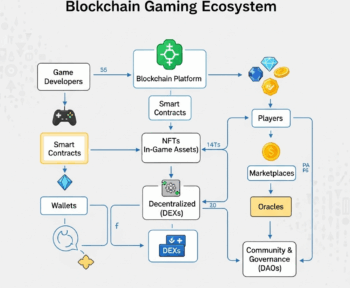Artificial intelligence has transcended its role as a simple opponent behavior system to become the cornerstone of modern game development, fundamentally transforming how games are created, experienced, and evolved. From procedurally generated infinite worlds to NPCs with genuine personality, AI technologies are enabling gaming experiences that would have been impossible just a few years ago1.
The Evolution of Procedural Content Generation
Procedural content generation (PCG) has evolved from simple random dungeon layouts to sophisticated systems creating entire universes with coherent geography, ecosystems, and histories. Modern PCG algorithms combine multiple AI techniques including neural networks, genetic algorithms, and constraint satisfaction to generate content that feels handcrafted rather than random.
No Man’s Sky pioneered the concept of an AI-generated universe with 18 quintillion planets, each with unique topography, flora, and fauna. The game’s engine uses deterministic algorithms that can recreate any planet from a seed value, ensuring persistence without storing petabytes of data. This approach demonstrates how AI enables experiences of unprecedented scale without corresponding storage requirements.
Wave function collapse algorithms have revolutionized level design by generating layouts that respect complex architectural and gameplay constraints. These systems analyze example levels to learn patterns and relationships, then generate new content that maintains stylistic consistency while ensuring playability. Games like Bad North and Townscaper showcase how these algorithms create aesthetically pleasing and functionally sound environments with minimal developer input.
Neural Networks in Game Asset Creation
Deep learning models have begun automating the creation of game assets, traditionally one of the most time-consuming aspects of game development. Generative adversarial networks (GANs) create textures that tile seamlessly while maintaining visual variety. These AI-generated textures are increasingly indistinguishable from artist-created assets while requiring a fraction of the production time.
Style transfer networks enable rapid art production by applying artistic styles to base geometry or sketches. Developers can define a visual style through example images, then have AI apply that style consistently across thousands of assets. This technology democratizes game development by enabling small teams to achieve visual consistency typically requiring large art departments.
AI-powered animation systems use machine learning to generate realistic character movements from minimal input. Motion matching algorithms blend captured animations seamlessly based on context, while physics-based controllers learn to navigate complex terrains naturally. These systems produce fluid, responsive character animation that adapts to any situation without requiring extensive motion capture or manual animation.
Dynamic Narrative Generation
Language models have revolutionized narrative design by enabling dynamic story generation that responds to player choices in unprecedented ways. Rather than following predetermined branching paths, AI-powered narrative systems generate dialogue, quest descriptions, and story events based on player actions and world state.
AI Dungeon demonstrated the potential of large language models in gaming, creating infinite text adventures that respond coherently to any player input. While early implementations suffered from consistency issues, modern systems use contextual memory and fine-tuning to maintain narrative coherence across extended play sessions.
Procedural quest generation systems combine narrative AI with gameplay objectives to create meaningful content beyond simple fetch quests. These systems analyze player behavior, preferences, and progression to generate personalized challenges that maintain engagement while respecting narrative consistency. The result is content that feels purposefully designed despite being algorithmically generated.
Adaptive AI Opponents and Difficulty
Modern game AI extends far beyond simple state machines to create opponents that learn and adapt to player strategies. Reinforcement learning algorithms train AI agents through millions of simulated matches, developing strategies that challenge even expert players while remaining fair and enjoyable for newcomers.
Dynamic difficulty adjustment (DDA) systems use machine learning to maintain optimal challenge levels for individual players. These systems analyze performance metrics in real-time, adjusting enemy behavior, resource availability, and encounter frequency to keep players in a flow state. Unlike traditional difficulty settings, AI-driven DDA provides personalized experiences that evolve throughout play sessions.
Imitation learning enables AI opponents to mimic human playing styles, creating more natural and varied challenges than traditional scripted behaviors. By training on recordings of human players, these systems learn the nuances and imperfections that make opponents feel authentic rather than mechanical.
Personalized Gaming Experiences
Player modeling AI creates detailed profiles of individual gaming preferences, skill levels, and behavioral patterns. These models inform every aspect of the game experience, from recommended difficulty settings to preferred quest types and reward structures. The result is games that feel personally crafted for each player.
Recommendation systems powered by collaborative filtering and deep learning suggest content based on player history and similar users’ preferences. These systems extend beyond simple “players who liked X also liked Y” to understand complex preference patterns and predict enjoyment of novel content types.
Emotional AI analyzes player reactions through gameplay patterns, adjusting narrative tone, music, and pacing to maintain desired emotional states. Horror games might reduce intensity when detecting player stress, while action games could escalate encounters when sensing boredom. This emotional awareness creates more engaging and comfortable gaming experiences.
Real-Time World Simulation
AI enables complex world simulations where thousands of NPCs maintain schedules, relationships, and goals independent of player interaction. These living worlds create emergent gameplay opportunities as NPC actions ripple through interconnected systems, generating unique scenarios without scripted events.
Economic simulation AI manages virtual economies with supply and demand, inflation, and market manipulation. NPCs make economic decisions based on personal needs and market conditions, creating realistic price fluctuations and trade opportunities. Games like X4: Foundations demonstrate how AI-driven economies create engaging gameplay without developer intervention.
Ecosystem simulation uses AI to model predator-prey relationships, migration patterns, and environmental changes. Virtual creatures exhibit realistic behaviors including hunting, mating, and territorial disputes. These systems create dynamic worlds where player actions have far-reaching consequences on virtual ecosystems.
Cloud-Powered AI Processing
Cloud computing has removed local hardware constraints on AI processing, enabling sophisticated algorithms that would be impossible on consumer devices. Games can offload complex AI calculations to cloud servers, returning results in real-time without impacting local performance.
Distributed AI processing enables massive multiplayer simulations where thousands of AI entities interact simultaneously. Cloud infrastructure handles the computational load of pathfinding, decision-making, and behavior simulation for entire virtual cities or battlefields.
Machine learning models can be continuously updated in the cloud based on aggregate player data, improving AI behavior without requiring game patches. This enables games to evolve and improve post-launch, with AI opponents becoming more sophisticated as they learn from millions of player interactions.
Ethical Considerations and Challenges
The use of AI in gaming raises important ethical considerations around addiction, manipulation, and fairness. Personalization algorithms optimized for engagement could exploit psychological vulnerabilities, creating unhealthy gaming habits. Developers must balance engagement optimization with player wellbeing.
AI-generated content raises questions about authorship and creativity. When AI creates compelling narratives or beautiful artwork, who deserves credit? How do we value human creativity when machines can produce similar results? These philosophical questions will become increasingly relevant as AI capabilities expand.
Bias in AI systems can perpetuate or amplify societal prejudices. Training data reflecting historical biases can result in AI that exhibits discriminatory behavior. Developers must carefully audit AI systems to ensure fair and inclusive gaming experiences for all players.
Future Horizons in AI Gaming
Artificial general intelligence (AGI) could enable NPCs with human-level reasoning and emotional depth. Imagine companions that remember shared experiences, develop genuine relationships, and exhibit complex personalities that evolve over time. These AI entities would blur the line between scripted characters and sentient beings.
Quantum computing could exponentially expand AI capabilities in gaming, enabling real-time simulation of complex systems currently impossible with classical computers. Quantum AI could generate entire universes with consistent physics, evolution, and history in real-time.
Brain-computer interfaces combined with AI could create unprecedented immersive experiences. AI could interpret neural signals to understand player intent before conscious action, creating seemingly telepathic game controls and responsive worlds that adapt to subconscious player desires.
The convergence of AI with other emerging technologies promises gaming experiences beyond current imagination. AI-powered virtual beings in augmented reality could create persistent companions that exist across games and platforms. These digital entities could become as meaningful as human relationships, fundamentally changing the nature of gaming and social interaction.





